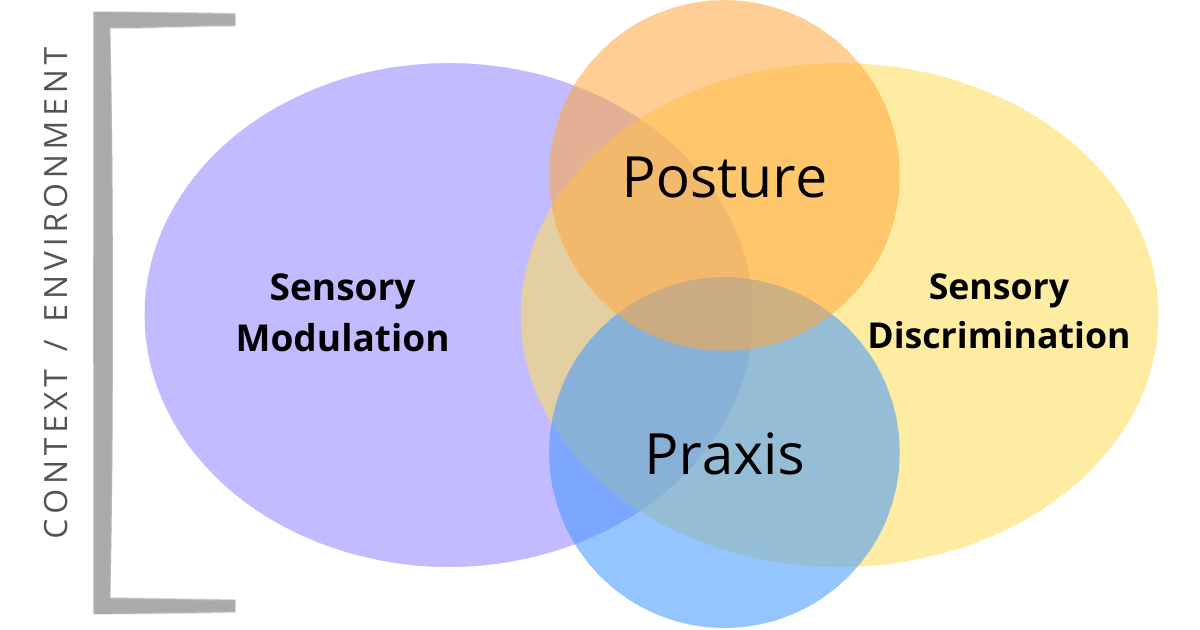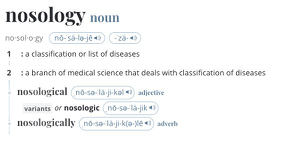Updating Our Thinking
Introduction
Recent attendees of the amazing STAR Symposium last week heard me say that “we were retiring the nosology” as a part of the STAR Frame of Reference. Well, they sort of heard me, really it was a recording of me. So, they heard my big floating head announce—in a British accent and croaking through a sore throat—that we are retiring the nosology. I suspect it sounded a little like the royal we which may have been a little confusing. If you missed it, you can pre-order access to the presentation alongside the rest of the AMAZING symposium over at our online learning platform or read the transcript here.
The comments at symposium only refer to the 2007 nosology.
Miller, L. J., Anzalone, M. E., Lane, S. J., Cermak, S. A., & Osten, E. T. (2007). Concept evolution in sensory integration: A proposed nosology for diagnosis. American Journal of Occupational Therapy, 61(2), 135–142. https://doi.org/10.5014/ajot.61.2.135
Retiring the Nosology
Specifically, we are no longer using the 2007 nosology as the organizing schematic for sensory processing disorder in the STAR Frame of Reference although as you will see below, our new developing framework for education does not deviate very much from this model and incorporates current research. The 2007 nosology is 16 years old, it’s almost old enough to vote! As instructed by our Director Emeritus Dr. Lucy Miller, we have been waiting for data but gathering new data keeps being thwarted. The most obvious example being how much the Covid-19 pandemic interrupted research. Dr. Miller has been saying for a decade that the nosology needs data. The original 2007 document was theoretical which is good place to start but needs to be validated by empirical data. The typology Miller, Schoen, & Mulligan are working on will come from the new data gathered as part of the SP3-D development and that will inform our work at STAR Institute as soon as its available.
In other words: we are pivoting to use of an educational tool focused on making features of sensory integration and processing accessible and easy to understand. We hope to produce resources that align with best practices in health literacy and offer a valuable contribution to the field. We also wait for other groups to update our understanding of how differences in sensory integration and processing[1] cluster together meaningfully, especially data from the EASI and SP3-D. Dr. Miller, Dr. Schoen, and Dr. Mulligan are doing this work as they develop and refine the Sensory Processing 3-Dimensions Assessment. As they refine measurement best practices and gather data, they will be very deliberately organizing thinking around significantly similar presentations of differences in the sensory integration process. (Again, it might be helpful here to read the transcript of what Dr. Spielmann said at symposium). The SP3-D is a measurement tool developed based on years of clinical wisdom and experience and we cannot wait to see what the data gathered tells us about the ways in which we understand sensory processing and integration differences and functioning.
The central pillar of the STAR Frame of Reference is the intersection of regulation, relationships, and the sensory integration process. That will never change.
This is happening at this time because we are deliberately moving away from language that frames differences as deficits, while still recognizing that for some individuals these differences interfere with daily life. Again we value data driven phenotyping and other teams are doing that work. Our educational framework will be a layered and multifaceted. The graphic you see below is just the first layer. A way of introducing a complex subject to people, as people learn more there will be more graphics, and greater complexity will be represented at each layer.
Our framework for understanding sensory integration and processing features aligns with data driven models and … as noted above, in many ways it doesn’t significantly differ from the 2007 nosology. The 2023 framework for understanding sensory integration and processing features is the beginning of a health literacy campaign. It is aligned with data driven models (for example the Bundy and Lane model of sensory integration differences) and protects the ‘best bits’ of the 2007 Miller nosology. Take a look it’s Figure 1.

Figure 1. Framework for Understanding Sensory Integration and Processing Features
You may notice that this framework includes discrimination (referred to as perception by some models) although not as a completely siloed subtype. We recognize that while a person might have a stand-alone auditory discrimination difference, vestibular, proprioceptive, and tactile discrimination differences always map to differences in posture and praxis. Sensory craving is not represented either; the data is too limited and obscure at present for this behavior to be represented as its own subtype. However, this behavior pattern may sometimes present and deserves to be addressed in some capacity [2]. In the sensory modulation (sensory reactivity) part of the graphic educators can add an up-arrow to represent sensory over responsivity/reactivity or hyper-responsivity. And/or a down-arrow to represent lower-responsivity also known as sensory under reactivity or hypo-responsivity.
Did you know that in the recent, and excellent book, on adult autism assessments, the general language around sensory integration and processing differences was criticized as neuronormative? Whether or not you think this perspective is valid it reflects a barrier to people’s engagement with the work.
“Much of the terminology used to talk about autistic sensory processing comes from the stance of an ablest and biased perspective of Neurotypical sensory processing being the ‘gold standard’, close, speech, marks, and anything deviating from this as being disordered. Terms such as ‘over’ or ‘under’-responsive are not Neuro-Affirmative and are not based on some objective measure of reality and correct response but again, are judged against what is typical for neurotypicals. It makes little sense to say Autistic people are over-responsive to auditory information when they can hear sounds that do exist but that neurotypicals cannot hear. This type of judgment lacks reason but regardless, it is a judgment that is often made when talking about sensory processing.
In reality, Autistic sensory systems are different. It is not that Autistic people have too much or too little of a reaction, but that their responsivity to the sensory stimuli is different to neurotypicals, because they have different brains and different perceptual mechanisms. It is not a sensory problem out of context. Yes, it can be a sensory problem because of how society and the environment is designed, but internal to the autistic person, it is not that they have a deficit or malfunctioning sensory system; they just have a different sensory system.”
Hartmen, D., O’Connell-Killen, T., Doyle, J.K., Kavanagh, M., Day, A., & Azevedo, J. (2023) Page 100. The Adult Autism Assessment Handbook: A Neurodiversity Affirming Approach. London, Jessica Kingsley Publishers
One of Dr. Miller’s strengths is her ability to take dense and complex phenomenon and make them relatable. No one agrees with this more than our Clinical Director, Mim Ochsenbein. Mim says that “Dr. Miller’s nosology was the iPhone of sensory integration theory, it was relatable, that was genius. Everything else felt like a blackberry!”. This is something we want to protect as we develop relatable and understandable health literacy tools regarding sensory integration and processing.
We are working hard to unlearn all our internalized ableist tendencies. We are committed to professional reflection at STAR. That means doing better with our therapeutic use of self, and it means that we are committed to noticing and actively working to deconstruct systems of oppression. We are focused on unlearning ableism, and in so doing to changing our perspective. That means changing the formalized tools we use to support clinical reasoning. However, it doesn’t mean that all the work that has been done is defunct. We are in the privileged position of being able to incorporate the best parts of our previous way of thinking as we develop our what’s next.
STAR is NOT doing the data gathering necessary to develop a data driven typology of sensory integration and processing differences. So, we wait with excitement for the findings of the SP3-D and EASI teams.
Dr. Miller ALWAYS said that the nosology was a living breathing entity – one of Dr. Miller’s greatest lessons was that we should always be learning and always intentionally doing better and getting better. That’s all this is. STAR is built on a foundation of research that means always asking questions, seeking the best answers, never being satisfied with the status quo, and being willing to change. Dr. Miller has always insisted we embody these principles and in doing so follow Dr. Ayres example. I hope you will join us!
TLDR: At the recent STAR Symposium Dr. Spielmann announced the retirement of the 2007 nosology, or classification system of diseases, from the STAR Frame of Reference. The reason for this is twofold: the nosology has not been updated since 2007, and it was always intended to be a living evolving document. The 2007 Miller nosology is no longer the organizing schematic for differences in sensory integration and processing at STAR and will be replaced with a new framework that is similar and incorporates current research-driven modeling. The new framework also aims to move away from viewing differences as deficits, be more inclusive and less neuronormative. The STAR Institute is not involved in data gathering for developing a new typology of sensory integration and processing differences, but eagerly awaits the findings of the SP3-D and EASI teams. STAR remains committed to constant learning and improvement, following the directive of Dr. Lucy Miller and example of Dr. Ayres.
Want to learn more? Register HERE for the mini-series, where Dr. Spielmann breaks down these concepts.
The bundled package, with live and recorded access, is available for only $75 (or $30/webinar).
[1] Per AOTA guidelines the term “Sensory Integration and Processing” is used throughout this blog post.
[2] Separate blog post on perspectives of sensory craving to come!

